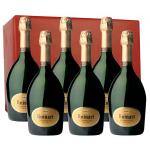Champagne
| Infobox on Champagne | |
|---|---|
| Example of Champagne |  |
| Facts | |
| Origin | France |
| Stowage factor (in m3/t) | 1,9 - 2,2 m3/t (cases) |
| Humidity / moisture | - |
| Oil content | - |
| Ventilation | - |
| Risk factors | See text |
Champagne
Description / Application
Champagne is a sparkling wine produced from grapes grown in the Champagne region of France following rules that demand secondary fermentation of the wine in the bottle to create carbonation. Some use the term champagne as a generic term for sparkling wine, but many countries reserve the term exclusively for sparkling wines that come from Champagne and are produced under the rules of the appellation.
The primary grapes used in the production of Champagne are Pinot noir, Chardonnay and Pinot Meunier. Champagne appellation law only allows grapes grown according to appellation rules in specifically designated plots within the appellation to be used in the production of Champagne. Some sparkling wines produced in other regions of the world use other grapes.
The Champagne winemaking community, under the auspices of the Comité Interprofessionnel du Vin de Champagne (CIVC), has developed a comprehensive set of rules and regulations for all wine produced in the region to protect its economic interests. They include codification of the most suitable growing places; the most suitable grape types (most Champagne is a blend of up to three grape varieties, though other varieties are allowed); and a lengthy set of requirements specifying most aspects of viticulture. This includes pruning, vineyard yield, the degree of pressing, and the time that wine must remain on its lees before bottling. It can also limit the release of Champagne to market to maintain prices. Only when a wine meets these requirements may it be labelled Champagne. The rules agreed upon by the CIVC are submitted for the INAO's final approval.
Shipment / Storage / Risk factors
Shipped in bottles, in cases, usually 12 bottles per carton, with interlining bottle protection.
May be damaged by heat, close proximity to fire, etc. Over-stow or impact can cause damage to cork and/or metal foil, wiring, etc., which may adversely affect contents.











